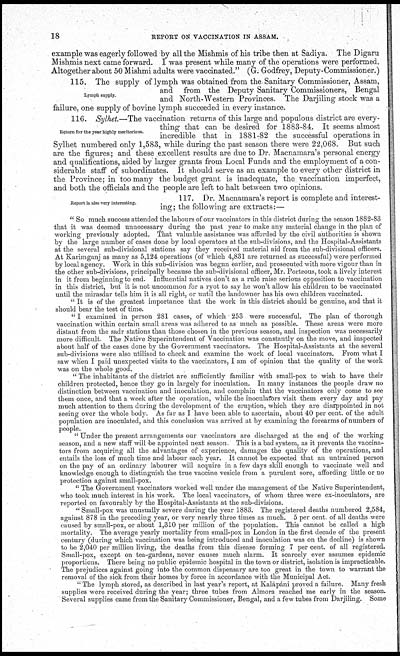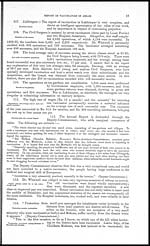Medicine - Vaccination > 1874-1927 - Annual vaccination report of the province of Assam > Vaccination report Assam 1874-1896 > 1883-1884 - Annual vaccination report of the Province of Assam for the year 1883-84
(82) Page 18
Download files
Individual page:
Thumbnail gallery: Grid view | List view

18 REPORT ON VACCINATION IN ASSAM.
example was eagerly followed by all the Mishmis of his tribe then at Sadiya. The Digaru
Mishmis next came forward. I was present while many of the operations were performed.
Altogether about 50 Mishmi adults were vaccinated." (G. Godfrey, Deputy-Commissioner.)
Lymph supply.
115. The supply of lymph was obtained from the Sanitary Commissioner, Assam,
and from the Deputy Sanitary Commissioners, Bengal
and North-Western Provinces. The Darjiling stock was a
failure, one supply of bovine lymph succeeded in every instance.
Return for the year highly meritorious.
116. Sylhet.—The vaccination returns of this large and populous district are every-
thing that can be desired for 1883-84. It seems almost
incredible that in 1881-82 the successful operations in
Sylhet numbered only 1,583, while during the past season there were 22,068. But such
are the figures; and these excellent results are due to Dr. Macnamara's personal energy
and qualifications, aided by larger grants from Local Funds and the employment of a con-
siderable staff of subordinates. It should serve as an example to every other district in
the Province; in too many the budget grant is inadequate, the vaccination imperfect,
and both the officials and the people are left to halt between two opinions.
Report is also very interesting.
117. Dr. Macnamara's report is complete and interest-
ing; the following are extracts:—
" So much success attended the labours of our vaccinators in this district during the season 1882-83
that it was deemed unnecessary during the past year to make any material change in the plan of
working previously adopted. That valuable assistance was afforded by the civil authorities is shown
by the large number of cases done by local operators at the sub-divisions, and the Hospital-Assistants
at the several sub-divisional stations say they received material aid from the sub-divisional officers.
At Karimganj as many as 5,124 operations (of which 4,831 are returned as successful) were performed
by local agency. Work in this sub-division was begun earlier, and prosecuted with more vigour than in
the other sub-divisions, principally because the sub-divisional officer, Mr. Porteous, took a lively interest
in it from beginning to end. Influential natives don't as a rule raise serious opposition to vaccination
in this district, but it is not uncommon for a ryot to say he won't allow his children to be vaccinated
until the mirasdar tells him it is all right, or until the landowner has his own children vaccinated.
" It is of the greatest importance that the work in this district should be genuine, and that it
should bear the test of time.
" I examined in person 281 cases, of which 253 were successful. The plan of thorough
vaccination within certain small areas was adhered to as much as possible. These areas were more
distant from the sadr stations than those chosen in the previous season, and inspection was necessarily
more difficult. The Native Superintendent of Vaccination was constantly on the move, and inspected
about half of the cases done by the Government vaccinators. The Hospital-Assistants at the several
sub-divisions were also utilised to check and examine the work of local vaccinators. From what I
saw when I paid unexpected visits to the vaccinators, I am of opinion that the quality of the work
was on the whole good.
" The inhabitants of the district are sufficiently familiar with small-pox to wish to have their
children protected, hence they go in largely for inoculation. In many instances the people draw no
distinction between vaccination and inoculation, and complain that the vaccinators only come to see
them once, and that a week after the operation, while the inoculators visit them every day and pay
much attention to them during the development of the eruption, which they are disappointed in not
seeing over the whole body. As far as I have been able to ascertain, about 40 per cent. of the adult
population are inoculated, and this conclusion was arrived at by examining the forearms of numbers of
people.
" Under the present arrangements our vaccinators are discharged at the end of the working
season, and a new staff will be appointed next season. This is a bad system, as it prevents the vaccina-
tors from acquiring all the advantages of experience, damages the quality of the operations, and
entails the loss of much time and labour each year. It cannot be expected that an untrained person
on the pay of an ordinary labourer will acquire in a few days skill enough to vaccinate well and
knowledge enough to distinguish the true vaccine vesicle from a purulent sore, affording little or no
protection against small-pox.
" The Government vaccinators worked well under the management of the Native Superintendent,
who took much interest in his work. The local vaccinators, of whom three were ex-inoculators, are
reported on favourably by the Hospital-Assistants at the sub-divisions.
" Small-pox was unusually severe during the year 1883. The registered deaths numbered 2,584,
against 878 in the preceding year, or very nearly three times as much. 5 per cent. of all deaths were
caused by small-pox, or about 1,310 per million of the population. This cannot be called a high
mortality. The average yearly mortality from small-pox in London in the first decade of the present
century (during which vaccination was being introduced and inoculation was on the decline) is shown
to be 2,040 per million living, the deaths from this disease forming 7 per cent. of all registered.
Small-pox, except on tea-gardens, never causes much alarm. It scarcely ever assumes epidemic
proportions. There being no public epidemic hospital in the town or district, isolation is impracticable.
The prejudices against going into the common dispensary are too great in the town to warrant the
removal of the sick from their homes by force in accordance with the Municipal Act.
" The lymph stored, as described in last year's report, at Kalápáni proved a failure. Many fresh
supplies were received during the year; three tubes from Almora reached me early in the season.
Several supplies came from the Sanitary Commissioner, Bengal, and a few tubes from Darjiling. Some
Set display mode to: Large image | Zoom image | Transcription
Images and transcriptions on this page, including medium image downloads, may be used under the Creative Commons Attribution 4.0 International Licence unless otherwise stated. ![]()
| Permanent URL | https://digital.nls.uk/91524340 |
|---|
| Additional NLS resources: | |
|---|---|
| Attribution and copyright: |
|
|---|




